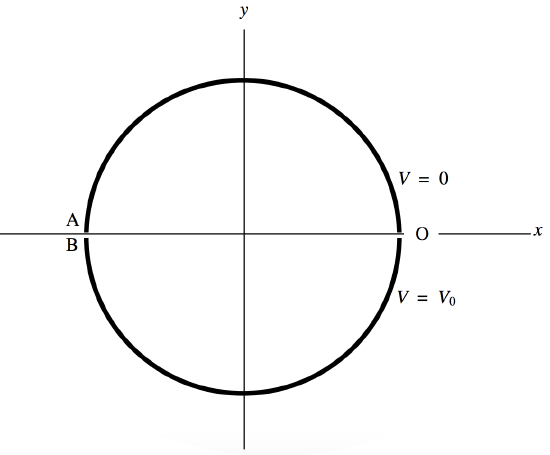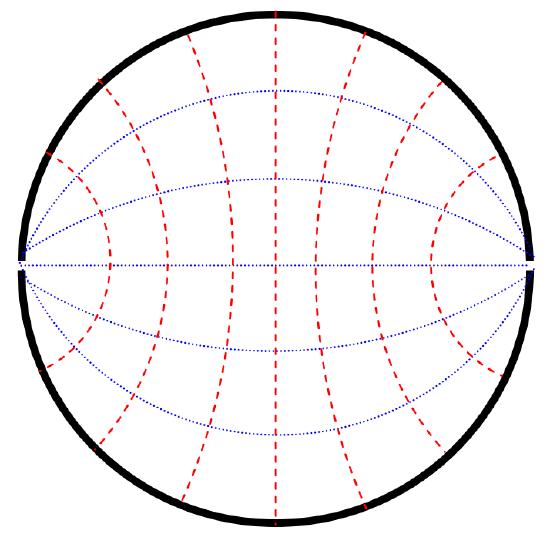2.6: Two Semicylindrical Electrodes
( \newcommand{\kernel}{\mathrm{null}\,}\)
This section requires that the reader should be familiar with functions of a complex variable and conformal transformations. For readers not familiar with these, this section can be skipped without prejudice to understanding following chapters. For readers who are familiar, this is a nice example of conformal transformations to solve a physical problem.

FIGURE II.5
We have two semicylindrical electrodes as shown in Figure II.5. The potential of the upper one is 0 and the potential of the lower one is V0. We'll suppose the radius of the circle is 1; or, what amounts to the same thing, we'll express coordinates x and y in units of the radius. Let us represent the position of any point whose coordinates are (x , y) by a complex number z=x+iy.
Now let w=u+iv be a complex number related to z by w=i(1−z1+z); that is, z=1+iw1−iw. Substitute w=u+iv and z=x+iy in each of these equations, and equate real and imaginary parts, to obtain
u=2y(1+x)2+y2;v=1−x2+y2(1+x)2+y2;x=1−u2−v2u2+(1+v)2;y=2uu2+(1+v)2.
In that case, the upper semicircle (V=0) in the xy-plane maps on to the positive u-axis in the uv-plane, and the lower semicircle (V=V0) in the xy-plane maps on to the negative u-axis in the uv-plane. (Figure II.6.) Points inside the circle bounded by the electrodes in the xy-plane map on to points above the u-axis in the uv-plane.

FIGURE II.6
In the uv-plane, the lines of force are semicircles, such as the one shown. The potential goes from 0 at one end of the semicircle to V0 at the other, and so equation to the semicircular line of force is
VV0=argwπ
or
V=V0πtan−1(v/u).
The equipotentials (V = constant) are straight lines in the uv-plane of the form
v=fu.
(You would prefer me to use the symbol m for the slope of the equipotentials, but in a moment you will be glad that I chose the symbol f.)
If we now transform back to the xy-plane, we see that the equation to the lines of force is
V=V0πtan−1(1−x2−y22y).
and the equation to the equipotentials is
1−x2−y2=2fy,
or
x2+y2+2fy−1=0
Now aren't you glad that I chose f ? Those who are handy with conic sections (see Chapter 2 of Celestial Mechanics) will understand that the equipotentials in the xy-plane are circles of radii √f2+1, whose centres are at (0,±f), and which all pass through the points (±1,0). They are drawn as blue lines in Figure II.7. The lines of force are the orthogonal trajectories to these, and are of the form
x2+y2+2gy+1=0
These are circles of radii √g2−1 and have their centres at (0,±g). They are shown as dashed red lines in Figure II.7.

FIGURE II.7


